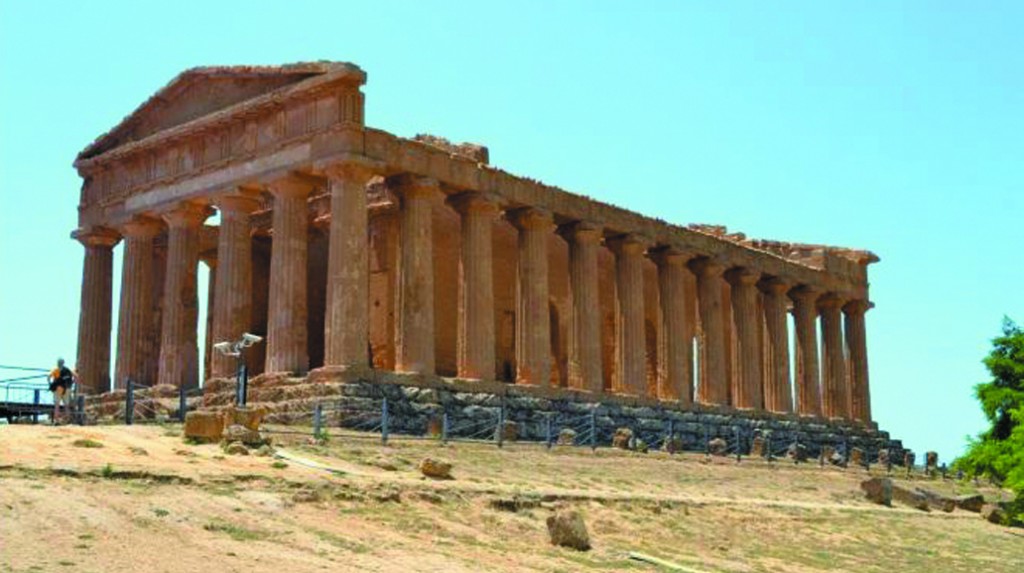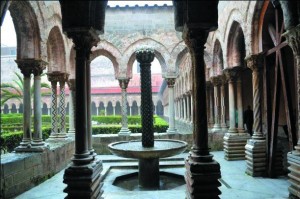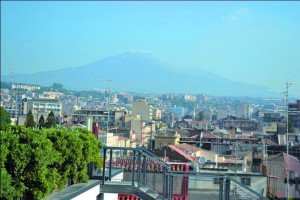Last Updated on September 30, 2012 by Editor

By A.J. VALENTINI
Mention Sicily to the average person on the street in America and visions of Mafiosi, exploding cars and gang shootouts come to mind.
That’s really too bad. This Vermont-sized island at the geographical center of the Mediterranean has been the crossroads of western civilization for more than 2,500 years. A trip earlier this year to this fascinating place was a reminder to my wife and me, lifelong students of Italian language and culture, of the greatness of this complicated land.
Our first port of call was the city of Palermo, Sicily’s largest city and regional capital. Founded by the Phoenicians in the 7th century BCE, it eventually became a Carthaginian base and later Roman. It sits in the shadow of Monte Pellegrino on the north along the “Conca d’oro,” a crescent of land bordered on the other end by Capo Zafferano. The German poet Goethe was so taken by its beauty that the captain of the ship upon which he arrived had to prod him from his stupor. The vestiges of its Arab and Norman rulers is present in its ornate Duomo, which rather than a Christian church looks more like a Moroccan fantasy.

In nearby Monreale, the duomo’s interior exhibits brilliant mosaics that rival those of the great Byzantine centers of the Mediterranean. Its adjoining Benedictine abbey has a cloister that may remind one of a scaled down version of Granada’s Alhambra with its ornate double-columned portico and arabesque fountain.
East of Palermo is found the duomo of Cefalù, built by the Norman King Roger II in the 12th century. It has a fortress-like entrance, complete with narrow windows in the towers from which archers could defend the terrorized citizenry who took refuge there during attacks. The dramatic setting of the building is not lost on the casual observer. It sits at the base of a huge rocky promontory that the Greeks said resembled a head. They named the place Kephalos, which over time became Cefalù.
At the western end of the island, the medieval town of Erice sits almost a half mile above the surrounding countryside upon the foundations of ancient Phoenician and Greek buildings. The imposing Castello di Venere is built on the exact spot where there was once a temple dedicated to Venus. The town’s Mother Church is actually built out of stone from that temple.
South of Erice is the city of Trapani, which derived ancient prosperity from the harvesting of sea salt and further along one discovers Marsala. Its name is derived from the Arab name Marsah el Ali (Port of Allah). Known today for its sweet wine, during the Italian Risorgimento Giuseppe Garibaldi began his campaign in 1860 here with his thousand men to free southern Italy from the power of the Bourbons.
On Sicily’s southern coast can be found some of the best preserved Greek temples in the Mediterranean basin in Agrigento’s Valley of the Temples. Here there was no marble, so early residents of ancient Akragas used the local stone and covered it with white plaster. It is said that the gleam of the ancient city could be seen miles out to sea. Pindar called it “man’s finest town.” Studying the stones, one can note Greek ingenuity in techniques of anti-seismic construction.

The eastern half of the island is dominated by Mount Etna, Europe’s largest and most active volcano. Many Greek legends were born here; the home of the Cyclops and the fiery furnace of the god Vulcan, for example. At the foot of the mountain is Sicily’s second largest city and industrial center, Catania. Like all the cities in this area, it is replete with gorgeous examples of Baroque architecture.
In 1693, a horrendous earthquake brought the area to its knees and almost every building down to its foundations. The Spanish Viceroys rebuilt the cities, mapping out organized city grids and filling them with gorgeously opulent monuments to their wealth. Catania also has had the flowing lava of Mount Etna to deal with. It is a city of two colors, the black basalt from the lava and the white limestone of nearby Siracusa to the south.
Siracusa, on the other hand, is far enough away from Etna to be spared its wrath. Founded in 753 BCE by Greeks from Corinth, it became one of the most powerful city-states in the ancient world, even taking on Athens, Carthage and Rome.
Its Duomo is the oldest continuously used religious structure in the world. It began as a Greek temple to Athena in the 5th century BCE, it then became a Roman temple, a Byzantine church, a mosque and then a church again. The center of the ancient city was on the island of Ortigia, but its largest collection of ancient monuments is on the mainland and includes the largest sacrificial altar in the Greek world, the remains of the stone quarry, a Roman amphitheater and one of the largest Greek theaters around.
Hewn out of the “living rock” of a hillside, it could accommodate 14,000 spectators at a performance. It is still used today for a Greek theater series every spring.
Almost to the southern tip of the island of Sicily is the jewel of Sicilian Baroque, the town of Noto. As previously stated, most of the cities had to be rebuilt after 1693. Noto was actually moved five kilometers to a new site so the planners began with a “tabula rasa.”
All is constructed out of the local limestone, which takes on different hues throughout the day. The neighborhoods are neatly divided between the social classes, yet all are designed to allow for maximum sunlight. Exterior and interior decoration provides a feast for the eyes and the local almond pastries and gelato provide a feast for the palate.
To the north of Catania one can visit another ancient theater in Taormina. Situated high above the straits of Messina, this garden spot offers awesome views of the coastline and mother Etna.
Its public gardens and private balconies bloom with a profusion of colorful flowers. Its theater, first constructed by the Greeks and subsequently modified by the Romans, hosts concerts and plays even today. Its shops are chock full of Sicilian handcrafts and designer ware.
So you see, there are many sides to the fascinating island of Sicily. Few places on earth can boast such history and artistic treasures. Summers are quite hot there but the beaches are plenty and there are shady spots and cool drinks to help keep the traveler comfortable. This writer highly recommends a visit to “la Sicilia!”